
AFS has prepared a simple example of model building. This example
has two series for some 54 monthly observations. To better understand AUTOBOX we
suggest that you simply download the data and build a model using whatever tools
you are comfortable with or have easy access to. You might even pass the data on
to a colleague and get their input. The point is simply that you get more out of
a presentation if you participate intellectually and develop a shared experience
rather than simply watching or reading. To this end, we have prepared moddata.zip
which contains the data. After you have done your "homework" the content
of the following will be more appreciated and you can then return to the rest of
this presentation. Statistics & Mathemathics are best learned by doing and reading.
Perhaps some material on the subject of least squares. Gauss (1821) and Legendre (1806), both suggested the idea of minimizing squared deviations; Gauss pointed out 'But of all principles ours is the most simple; by others we would be led into the most complicated calculations'. Galton (1886) first used the term 'regression' in papers describing the relationship between the height of the children and of parents. We have seen generalizations of this to GLS models where the degree of importance of a certain set of x,y points is specified or developed as AUTOBOX does via the bootstrap. Extending regression to time series data has created issues such as latent variables and incorrect hypothesis testing. This particular example illustrates the opportunity to develop correct lag or model structures and to adequately deal with outliers and non-gaussian error processes.
ONE INPUT SERIES : INPUT.DAT
ONE OUTPUT SERIES : OUTPUT.DAT
MONTHLY DATA STARTING 1992/4
Consider the circumstance where monthly data is collected for 54 consecutive
periods (1992/4 through 1995/9). We wish to develop a forecasting model that quantitatively
relates these two series.
| Year |
Month |
Input (X) |
Output (Y) |
| 1992 |
4 |
9977 |
3835 |
| 1992 |
5 |
12417 |
3456 |
| 1992 |
6 |
9129 |
4424 |
| 1992 |
7 |
9613 |
4858 |
| 1992 |
8 |
8528 |
4270 |
| 1992 |
9 |
10008 |
5788 |
| 1992 |
10 |
9208 |
6656 |
| 1992 |
11 |
10624 |
11351 |
| 1992 |
12 |
7106 |
7937 |
| 1993 |
1 |
10870 |
10905 |
| 1993 |
2 |
16577 |
9528 |
| 1993 |
3 |
20127 |
12025 |
| 1993 |
4 |
15691 |
10359 |
| 1993 |
5 |
14206 |
15087 |
| 1993 |
6 |
12079 |
13721 |
| 1993 |
7 |
7958 |
17215 |
| 1993 |
8 |
9924 |
12390 |
| 1993 |
9 |
9311 |
12596 |
| 1993 |
10 |
10046 |
8877 |
| 1993 |
11 |
6766 |
9257 |
| 1993 |
12 |
6202 |
8054 |
| 1994 |
1 |
4802 |
9128 |
| 1994 |
2 |
4201 |
7921 |
| 1994 |
3 |
5540 |
8629 |
| 1994 |
4 |
4244 |
8912 |
| 1994 |
5 |
4192 |
9064 |
| 1994 |
6 |
3766 |
8835 |
| 1994 |
7 |
3918 |
8067 |
| 1994 |
8 |
4351 |
7384 |
| 1994 |
9 |
3902 |
6069 |
| 1994 |
10 |
3845 |
5576 |
| 1994 |
11 |
4923 |
4962 |
| 1993 |
12 |
4283 |
3081 |
| 1994 |
1 |
7261 |
3510 |
| 1994 |
2 |
4471 |
3418 |
| 1994 |
3 |
3814 |
4072 |
| 1994 |
4 |
2704 |
2841 |
| 1994 |
5 |
3104 |
3602 |
| 1994 |
6 |
3219 |
3703 |
| 1994 |
7 |
3683 |
3499 |
| 1994 |
8 |
2841 |
2786 |
| 1994 |
9 |
3062 |
2899 |
| 1994 |
10 |
3126 |
3438 |
| 1994 |
11 |
3277 |
3782 |
| 1994 |
12 |
1820 |
2091 |
| 1995 |
1 |
2950 |
3155 |
| 1995 |
2 |
2439 |
3405 |
| 1995 |
3 |
2659 |
3062 |
| 1995 |
4 |
2588 |
2766 |
| 1995 |
5 |
2594 |
2864 |
| 1995 |
6 |
2146 |
2805 |
| 1995 |
7 |
2524 |
3056 |
| 1995 |
8 |
2242 |
3608 |
| 1995 |
9 |
2640 |
3223 |


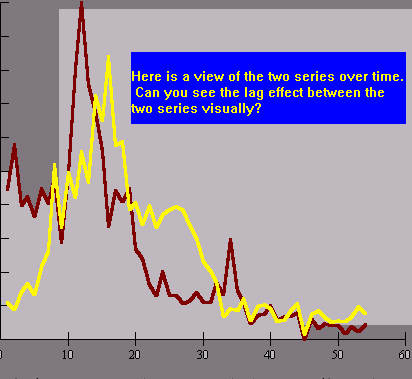
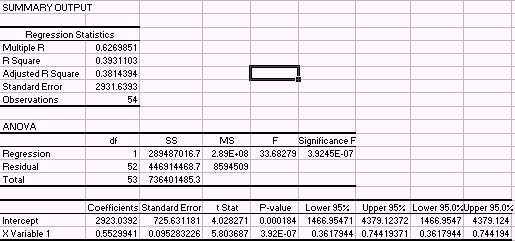


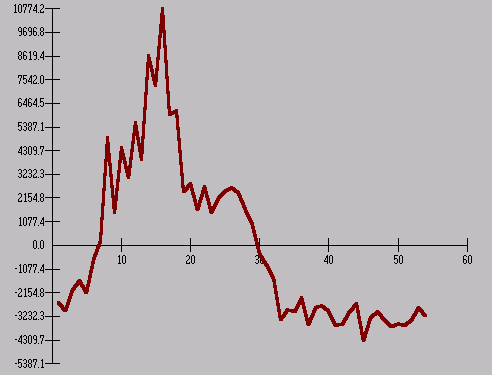
By plotting the residuals versus alternate lags of the input series
it is possible to identify needed model augmentation strategies. Here we show the
residuals and the input series lagged 0 periods illustrating the fact that the residuals
can be predicted thus they are non-gaussian.
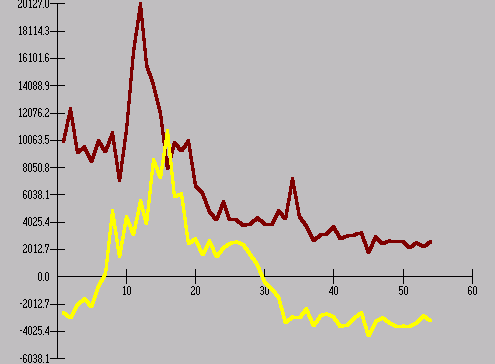
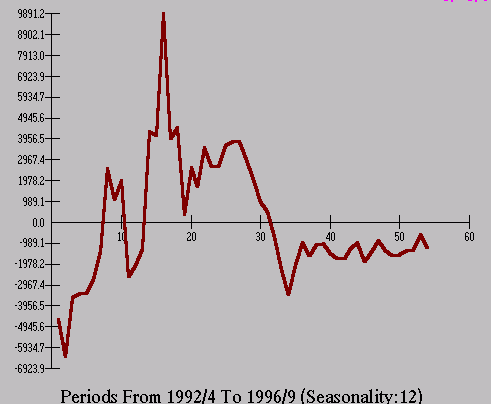
By plotting the residuals versus alternate lags of the input series
it is possible to identify needed model augmentation strategies. Here we show the
residuals and the input series lagged 4 periods illustrating the fact that the residuals
can be predicted thus they are non-gaussian.
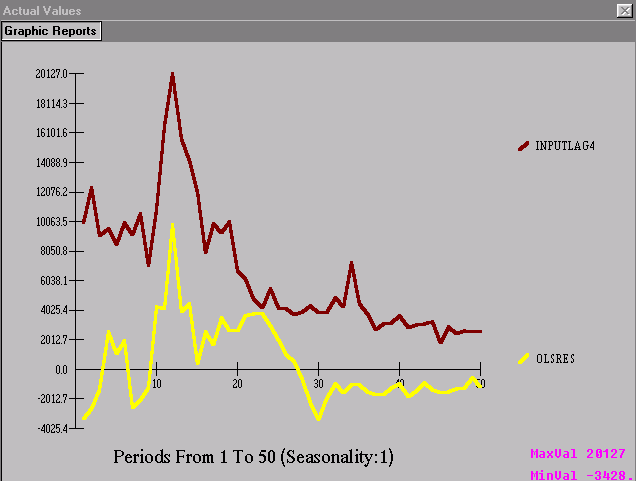
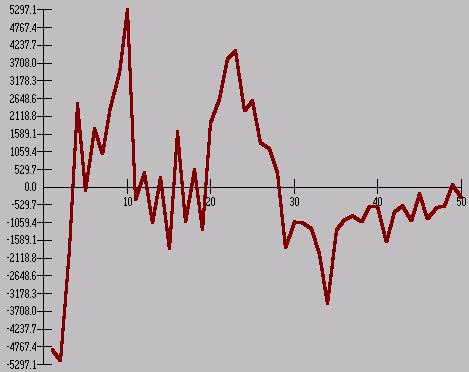
The residuals exhibit a clear random structure thus we can conclude
the modelling process.
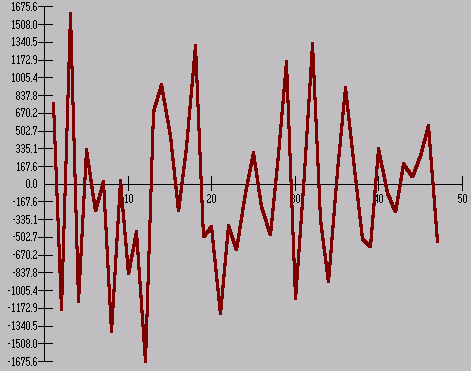

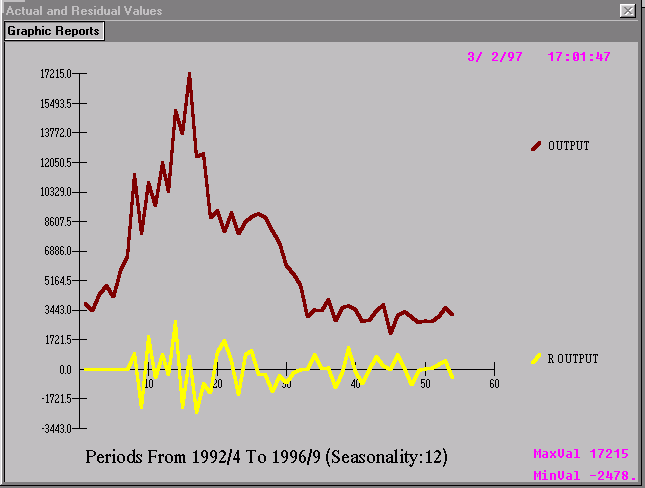
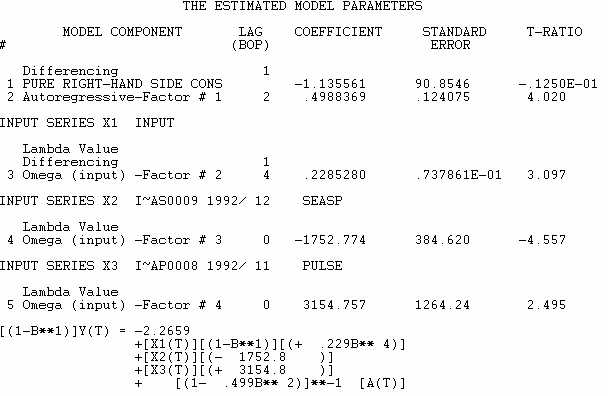
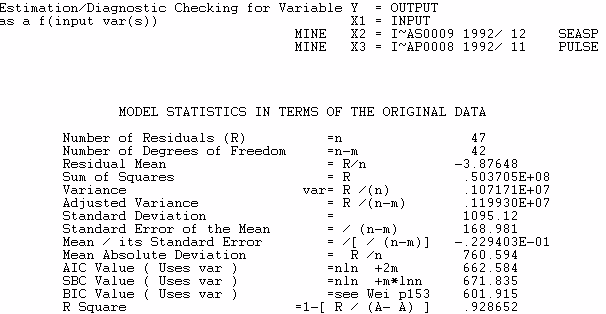
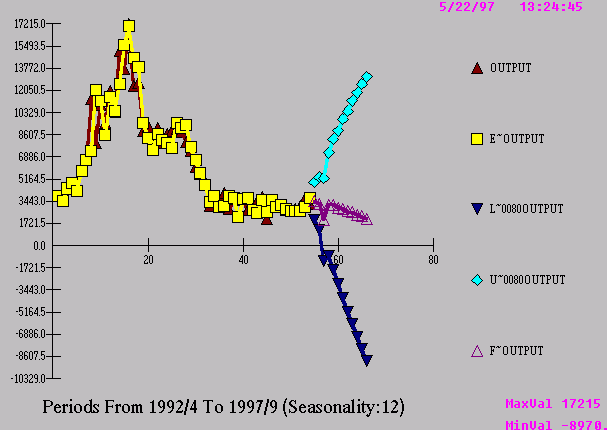
Click here to go to SELF-DIRECTED
TOUR
Click here to go to AFS SUGGESTED
TOUR
Click here to return to the home
page
![]()
P.O. Box 563
Hatboro, PA 19040
Tel: (215) 675-0652
Fax: (215) 672-2534
![]() sales@autobox.com
sales@autobox.com